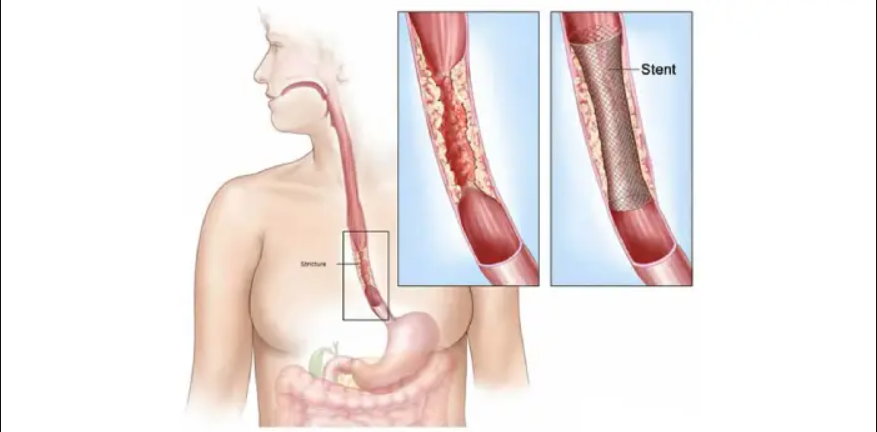-
drpvashistha@gmail.com
- +91 9004229819
Esophageal Stricture Dilation Treatment in Mumbai, Navi Mumbai
Esophageal stricture dilation is a medical procedure used to widen a narrowed or constricted esophagus. This condition, known as esophageal stricture, can be caused by various factors such as scarring from acid reflux or inflammation. During dilation, a flexible tube or balloon is inserted into the esophagus and inflated to stretch and expand the narrowed area, improving swallowing function for the patient.
Dr. Purushottam Vashistha Clinic in Mumbai and Navi Mumbai offers advanced and effective treatment for esophageal stricture dilation. Esophageal stricture refers to the narrowing of the esophagus, which can cause difficulty in swallowing and other complications. At Dr. Purushottam Vashistha Clinic, a team of experienced and skilled medical professionals utilizes state-of-the-art technology and techniques to perform esophageal stricture dilation.
The treatment involves the use of endoscopic procedures, where a thin, flexible tube with a balloon or dilator at its tip is inserted through the mouth and into the esophagus. The balloon or dilator is then inflated to gently stretch and widen the narrowed portion of the esophagus, relieving the obstruction.
Dr. Purushottam Vashistha Clinic is equipped with modern facilities and a patient-centric approach, ensuring a comprehensive and personalized care plan for individuals suffering from esophageal strictures. The clinic's commitment to providing high-quality healthcare makes it a trusted destination for those seeking effective Esophageal Stricture Dilation Treatment in the Mumbai, Navi Mumbai regions.
Esophageal Stricture Dilation Procedure
Dr. Purushottam Vashistha Clinic specializes in advanced esophageal stricture procedures, providing expert care and innovative treatments to address narrowing of the esophagus. With a focus on patient well-being, the clinic offers state-of-the-art solutions for improved quality of life.
- Local anesthesia may be administered to numb the throat, accompanied by medication to induce relaxation. The entire procedure typically lasts around 15 minutes and does not interfere with breathing.
- The process involves the use of an endoscope, a slender tube equipped with a small light and camera at its tip. This instrument is inserted through the mouth into the esophagus, providing a visual inspection. Additionally, fluoroscopy, a technique that produces a dynamic X-ray image on a computer screen, may be employed to assist in guiding the healthcare provider.
- Specialized miniature tools are then carefully maneuvered through the mouth into the esophagus to address the stricture. These tools are utilized based on the size and cause of the stricture. Different types include:
-
Balloon dilator: This involves inserting a deflated balloon into the stricture via an endoscope. The balloon is gradually inflated with air and then deflated once the stricture is appropriately widened. Balloon dilators are versatile and can treat various types of strictures.
-
Guided wire dilator: A thin wire is gently passed down the esophagus, and a small tube with varying widths on one end is guided down the wire. It is placed in the stricture to stretch it. This method is applicable for treating different types of strictures.
-
Bougies: These are weighted, cone-shaped tubes. Starting with smaller cones, the healthcare provider progresses to larger ones until the stricture is stretched to the desired extent. Bougies are commonly employed for simple strictures that are short, straight, and not overly narrow.
What are the common causes of Esophageal Stricture Dilation?
Esophageal stricture dilation is a medical procedure performed to widen a narrowed or constricted esophagus. The common causes for esophageal stricture dilation include:
- Gastroesophageal Reflux Disease (GERD): Persistent acid reflux can lead to inflammation and scarring of the esophagus, resulting in the formation of strictures. Esophageal dilation may be necessary to alleviate the narrowing caused by GERD.
- Eosinophilic Esophagitis: This is a chronic immune system-related disorder characterized by an overproduction of eosinophils in the esophagus, leading to inflammation and strictures. Dilation may be performed to relieve symptoms and improve swallowing.
- Ingestion of Caustic Substances: Accidental or intentional ingestion of corrosive substances can cause severe damage to the esophagus, leading to scar tissue formation and stricture. Dilation may be required to restore normal swallowing function.
- Post-Surgical Strictures: Certain surgical procedures, such as those to treat esophageal cancer or repair hernias, can sometimes result in scar tissue formation and narrowing of the esophagus. Esophageal dilation may be performed to address these post-surgical strictures.
- Inflammatory Conditions: Conditions such as Crohn's disease or other inflammatory disorders affecting the esophagus can contribute to the development of strictures. Esophageal dilation may be employed as part of the treatment plan to manage these conditions and improve swallowing function.
Urethral Stricture Dilation Treatment in Mumbai, Navi Mumbai
Urethral stricture dilation is a medical procedure used to treat a narrowing (stricture) in the urethra, the tube that carries urine from the bladder. During the dilation, a catheter or dilator is gently inserted into the narrowed area to widen and restore the normal flow of urine. This helps alleviate symptoms such as difficulty urinating and improves overall urinary function.
Dr. Purushottam Vashistha Clinic, located in Mumbai and Navi Mumbai, specializes in the treatment of urethral stricture through dilation procedures. Urethral stricture is a condition characterized by the narrowing of the urethra, which can lead to difficulties in urination. At Dr. Purushottam Vashistha Clinic, a comprehensive approach is taken to address this condition, with a focus on urethral stricture dilation treatment.
Urethral Stricture Dilation Treatment in Mumbai, Navi Mumbai involves the gentle stretching of the narrowed portion of the urethra to improve urine flow. This procedure is performed by Dr. Purushottam Vashistha, a highly experienced gastroenterologist and Hepatologist with a proven track record in managing urological conditions. The clinic is equipped with state-of-the-art facilities and adheres to the latest medical standards, ensuring that patients receive quality care.
The personalized and patient-centric approach at Dr. Purushottam Vashistha Clinic aims to alleviate the symptoms associated with urethral stricture, promoting better urinary function and enhancing the overall quality of life for individuals dealing with this condition.
Urethral Stricture Dilation Procedure at Dr. Purushottam Vashistha
Dr. Purushottam Vashistha specializes in Urethral Stricture Dilation procedures, providing expert care and precision in the treatment of urethral strictures. With a focus on patient well-being, Dr. Vashistha employs advanced techniques to effectively address this condition.
Patient Preparation:Before the procedure, the patient is typically given a local anesthetic to numb the urethra and reduce discomfort. In some cases, a mild sedative may be administered to help the patient relax.
Instrument Insertion:A thin, flexible tube called a catheter or a dilator is inserted into the urethra through the opening at the tip of the penis. The dilator is gradually advanced through the narrowed or blocked portion of the urethra.
Gradual Dilation:The dilation process involves gently stretching the narrowed area by incrementally increasing the size of the dilator. The healthcare provider carefully monitors the procedure to avoid causing injury to the urethral tissues.
Measurement and Assessment:The healthcare provider may use a measuring scale on the dilator to assess the degree of dilation and ensure that the urethra is adequately widened. Fluoroscopy or other imaging techniques may be employed to visualize the urethra and guide the dilation process.
Post-Dilation Evaluation:After the dilation is completed, the catheter or dilator is removed, and the healthcare provider evaluates the success of the procedure. Any immediate complications, such as bleeding or discomfort, are addressed, and the patient is monitored for a short period.
Post-Procedure Care and Follow-Up:Patients are often advised to avoid strenuous activities and to drink plenty of fluids to help flush out any debris or blood from the urinary system. Follow-up appointments may be scheduled to monitor the patient's progress and determine if additional treatments or dilations are necessary.
What are the causes for Urethral Stricture?
Urethral stricture dilation is a medical procedure used to treat urethral strictures, which are narrowed or blocked sections of the urethra. Several factors can contribute to the development of urethral strictures, and these may influence the decision to perform dilation. Here are five to six potential causes:
- Trauma or Injury: Physical trauma to the pelvic area or injury to the urethra, such as from a pelvic fracture or a straddle injury, can lead to the formation of scar tissue, resulting in a stricture.
- Infections: Sexually transmitted infections (STIs) or other infections affecting the urethra can cause inflammation and scarring, leading to the narrowing of the urethral passage.
- Inflammatory Conditions: Chronic inflammatory conditions like urethritis or conditions such as lichen sclerosus can contribute to the development of urethral strictures over time.
- Medical Procedures: Certain medical procedures, such as repeated catheterization or instrumentation of the urethra, can increase the risk of scarring and stricture formation.
- Congenital Factors: Some individuals may be born with a congenital predisposition to urethral strictures, which can become apparent later in life.
- Radiation Therapy: Radiation treatment for conditions such as prostate cancer can lead to scarring and fibrosis in the urethra, potentially resulting in strictures.
It's important to note that urethral stricture dilation is just one of the treatment options, and the choice of procedure depends on various factors, including the cause and severity of the stricture. Consult with our healthcare professional Dr. Purushottam Vashistha for accurate diagnosis and appropriate treatment.

